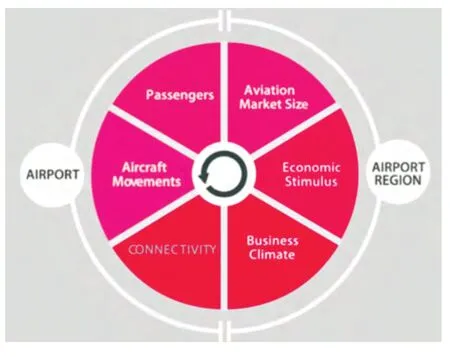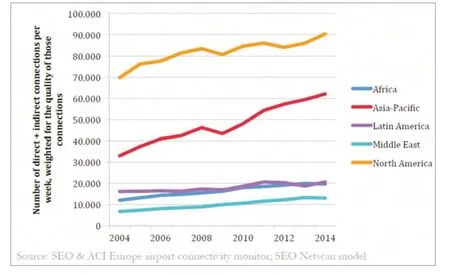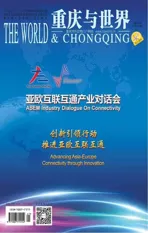互联互通——竞争力的关键加强亚欧航空互联互通,促进双方经济社会关系
2015-02-14GuillaumeBurghouwt
□ 文/Guillaume Burghouwt
●(Guillaume Burghouwt博士、荷兰SEO经济研究所、航空经济部主管)
航空互联互通——竞争力的关键
航空互联互通在当今经济全球化中起着至关重要的作用。对亚欧而言,要想从各自的发展潜力中获利,在双方的经济中心区域建立频繁可靠、方便快捷的航空联系则变得至关重要。保持良好的航空互联互通,是保障亚欧各城市和各区域处于强有力竞争力位置的基本要素。
不必讶异,无论是在地方、国家甚至国际的政策讨论中,互联互通都是一个越来越重要的话题。例如,伦敦某机场在讨论新增跑道时,连通新兴市场(如亚洲市场)则成为了讨论会的中心主题。欧盟委员会在其广受讨论的《欧盟对外航空政策交流》一文中也明确指出“互联互通乃竞争力的核心”。同样地,重庆举办的亚欧互联互通产业对话会不仅展现了“互联互通”在经济发展和区域一体化过程中日益明显的优势,同时也有利于加强互联互通。亚欧会议为亚欧各政府、企业、专家学者和其他利益相关者提供了一个平台,旨在加强两大区域的“经济繁荣和可持续发展,促进人才、贸易、投资、能源、信息、知识与思想之间的自由、无缝流动,加强各制度之间的联系。
越来越多的文献表明互联互通的价值以及与亚欧会议对话的关联性。诸多研究表明提高航空互联互通有利于增加经济福利收益,为机场区域创造良好的商业环境。增强航空互联互通,可以为广大消费者和商家带来可观的福利收益,因为具有良好互联互通的区域,可以在时间和金钱上(航空票价/运价),最大限度地减少旅行成本。巴塞罗那大学研究人员发现,欧洲各大城市每增加10%的洲际航空目的地(包括亚洲目的地),在其他所有条件相同的情况下,公司总部新增4%。根据最新一项关于欧洲机场经济影响的研究报告,航空互联互通每提高10%,则会带来0.5%的GDP增长。同时,也有越来越多的证据表明,良好的航空互联互通有利于提高员工的生产效率,促进国际贸易,吸引外国直接投资,刺激入境旅游的发展。

图1 互联互通的良性循环

提高互联互通的良性循环
互联互通提高与经济增长相互促进。良好的航空互联互通有利于促进区域经济与贸易的增长,进而提高航空服务需求。这是因为,提高某个区域的互联互通,会相应增加当地经济活动中的客流量,为当地旅游社区提供更高水平的服务。同时,航班数量和目的地的增加,本身也代表着良好的互联互通。这也就是我们所说的,互联互通的良性循环。航空互联互通不仅能促进经济增长,也能刺激自身发展。同样,任何一个机场或政府在制定其策略时可以将互联互通视为证明其增长的一个核心元素。
发展亚欧航空市场的互联互通
亚欧会议旨在促进亚欧成员国在互联互通、区域一体化和经济繁荣方面的合作。因此,就亚欧航空互联互通而言,我们究竟处于何种地位?
尽管这篇短短的文章没法给出详尽的互联互通分析,但是根据国际机场协会欧洲分会(ACI Europe)与SEO联合发表的《机场行业互联互通报告》,欧洲机场与亚洲之间的航空互联互通——以及与北美的互联互通考虑到了大多数的欧洲机场的洲际连接。此外,与世界其他区域相比,亚洲与欧洲机场的互联互通正在不断提高(见图2)。亚洲与欧洲机场相互连通,不仅带来了最高的绝对增长数字(欧洲机场服务的所有区域中),同时反映了这两大区域在贸易和旅游方面经济联系越来越紧密。从2004年到2014年,亚欧航空总体互联互通——所有直飞航班和需在中间枢纽机场转机的中转联程总数,各联程根据质量进行加权——几乎翻了一番(见图2)。直联增加了50%,中转联程(大部分)增长了90%。

图2 2004年至2014年,亚欧总体航空互联互通显著增加
获得连通性优势的方法
提高航空互联互通对于进一步增强亚欧经济与社会关系起着关键作用。值得高兴的是,在过去十年,这两大区域的航空互联互通已经得到显著提高。同时,我们也注意到了这两大区域的互联互通还有着很大的提升空间。
那么,在获取亚欧市场互联互通优势中,政府和行业利益相关者扮演着什么角色?在此,我们提出四点。
开放航空市场
开放航空市场是提高互联互通最基本和最重要的方法。而在相关航空运输协定中政府则起着带头作用。开放航空市场——从放松双边限制到使双边或多边协议完全自由化——促进提高航空服务(增加航班次数、开辟新的航空目的地),加强航空公司竞争。让更多乘客享受更加低廉的旅行费用。相应增加航空公司的成本效益。进而创造更多的机会,促进亚欧航空公司之间的合作,例如通过共用代码协议和联运。从而,提高自由市场的互联互通。
强大的枢纽航空公司
除亚洲航空公司提供亚欧间的直航服务外,法航-荷航、德国汉莎航空和英国航空等欧洲的全球性航空公司也在亚欧直连中扮演着至关重要的角色。这些航空公司所运营的枢纽航空网络让它们得以达到足够的乘客密度(将转机需求与当地需求相结合)以运营亚欧间的直航服务,而此类服务若仅靠当地需求是无利可图的。不过,全球性的欧洲航空公司现正承受着来自欧洲内(易捷航空、瑞安航空等廉价航空)外(主要是来自海湾国家和土耳其的航空公司)的强大竞争压力。而这些欧洲枢纽航空公司对提升自己竞争水平负有首要责任,它们应减少单位成本,并通过合并与收购进一步提高协同效应。
富有竞争力的旅游收费、机场容量和公平的竞争环境
除此之外,全球性航空公司在连通大都市区中所发挥的作用也需得到各地政府承认,并由它们确保(在各自法律系统权限内)为这些航空公司提供适宜的条件,以提升其竞争力。也就是说,除其他条件外,还要有充足的机场容量、有竞争力的收费水平(比如各种机场收费)和高效的空域设计。同样地,捍卫航空市场的竞争公平,让航空公司遵从同一套竞争准则行事,对构建一个健康强大的亚欧航空行业来说,以及最终对两个地区间的互联互通来说至关重要。
识别地图上的“白点”
在过去十年中,亚欧间的互联互通有了大幅提高。不过,“白点”又是什么呢?换言之,哪些航线在客流量方面已拥有足够的直航服务潜力,但却尚未提供直航服务?哪些市场因受到双边协议或机场拥堵瓶颈限制而难以加强空中的互联互通?哪些具备潜力的亚欧新航线正徘徊于需求充足线边缘,且在适当刺激下即可开通?哪些具备潜力的新航线可能在未来几年中拥有足够的需求?另外,哪些新的亚欧间航空服务能同时赢得两地商务群体的亲睐?
结论
航空互联互通是加强亚欧间经济与社会联系,以实现两个地区间互利的关键。亚欧会议对话恰如其分地认可了互联互通可带来的经济价值。亚欧间的航空互联互通,无论直接或间接,都在过去十年中得到了大幅提升。不过,可提升互联互通水平的机会还有很多。航空协议的开放、白点的识别、具有竞争力的费用水平、以及充足的机场容量等,都是政府及行业利益相关者可能不得不进一步探索的重要机会。
Connectivity by Air is Key to Competitiveness
Connectivity by air is key in today’s globalized economy.For Europe and Asia to benefit from each other’s growth potential,frequent,reliable and convenient air links between the economic centers in both regions are important.Good connectivity by air is an essential element for the competitive position cities and regions in both Asia and Europe.
Not surprisingly,connectivity is an increasingly important topic in policy discussions,on the regional,national and international level.For example,connectivity to emerging markets (for example in Asia) is a central theme in the debate around an additional runway at one of the London airports.But also the European Commission explicitly states that ‘connectivity is key to competitiveness’in its widely discussed paper Communication on the EU’s external aviation policy.As such,the ASEM Industry Dialogue in Chongqing reflects the growing importance of “connectivity excellence”in economic development and regional integration,but at the same time contributes to enhancing connectivity.ASEM serves as a platform for governments,companies,scholars and other stakeholders from both European and Asia with the aim to enhance connectivity between the two regions for “economic prosperity and sustainable development and to promoting free and seamless movement of people,trade,investment,energy,information,knowledge and ideas,and greater institutional linkages”.
A growing body of literature supports the value of connectivity and therefore the relevance of the ASEM dialogue.Many studies have shown that air connectivity improvements translate in economic welfare gains and a better business climate in the airport region.Air connectivity growth results in considerable welfare gains for consumers and businesses as a well-connected region minimizes travel costs in both time and money (air fares/ freight rates).Researchers of the University of Barcelona2 found that a 10% growth in intercontinental destinations in European cities (including to destinations in Asia) results in a 4% growth in the number of company headquarters,all other things being equal.According to a recent study on the economic impact of European airports3 ,a 10% connectivity growth generates a 0.5% growth in GDP.But there is also increasing evidence that better air connectivity improves productivity of employees,generates international trade,attracts foreign direct investments and stimulates inbound tourism.
The Virtuous Circle of Connectivity Growth
The relationship between connectivity growth and economic growth is a synergetic one.The regional economic and trade gains resulting from better air connectivity again generate more demand for air services.This is because the improved connectivity of a region allows for greater throughput of passengers with commensurate increase in local economic activity,as well as higher service levels to the benefit of the local travelling community.The increase in number of flights and destinations may in itself again represent a better connectivity performance.This is what we call the virtuous circle of connectivity.Connectivity by air facilitates economic growth but can also act as its catalyst.As such,connectivity can be a central element in any airport’s or government’s strategy to demonstrate its license to grow.

Figure1 The virtuous circle of connectivity Source: ACI Europe & SEO (2014).Airport industry connectivity report.

Figure2 Total connectivity by air between Europe and Asia has increased considerably between 2004 and 2014
Development of Connectivity by Air in the Europe to Asia Market
ASEM aims to increase cooperation between its Asian and European members as to enhance connectivity,regional integration and economic prosperity.So where do we stand in terms of the connectivity by air between Europe and Asia?
Although a full connectivity analysis is beyond the scope of this short contribution,according to the Airport industry connectivity report4 by ACI Europe and SEO,connectivity by air from European airports to Asia takes account —together with the connectivity to North America- of the majority of intercontinental connections from European airports.In addition,Asia is closingin terms of the connectivity provided to European airports compared to other world regions (figure 2).Connectivity between Europe and Asian airports showed the highest absolute growth figures of all world regions served by European airports,reflecting the growing economic linkages between both regions in terms of trade but also tourism.Between 2004 and 2014,total Europe-Asia connectivity —the sum of all direct flights and indirect connections with a transfer at an intermediate hub airport,weighted for the quality of each connection- almost doubled (figure 2).Direct connectivity increased by about 50%,whereas indirect connectivity (the lion’s share) increased by 90%.
Instruments to Achieve Connectivity Excellence
Air connectivity growth is crucial for further strengthening of the economic and social relationships between Asia and Europe.The good news is that connectivity by air has grown considerably during the past decade.At the same time,we notice that many opportunities for connectivity growth exist.
Which role can governments and industry stakeholders play to achieve connectivity excellence in the Europe to Asia market? We highlight four of them.
Opening up of aviation markets
The opening up of aviation markets is the first and most important instrument to achieve connectivity growth.And governments are in the lead as far as air service agreements are concerned.Opening up aviation markets —ranging from less tight bilateral restrictions to fully liberalised bilateral or multilateral agreements- stimulates air service growth (frequencies,new destinations) and airline competition.More passengers will travel at lower fares.Airline cost efficiency increases.More opportunities are created for cooperation between European and Asian carriers,for example through codeshare agreements and alliances.Connectivity in liberalised markets will grow.
Strong hub carriers
The European network carriers such as Air France-KLM,Lufthansa and British Airways are crucial of the direct flight connections between Europe and Asia,besides the services of their Asian counterparts.The hub networks these carriers operate allow them to achieve sufficient passenger density (combined transfer and local demand) to operate direct services between Asia en Europe,which would not be profitable based on local demand alone.Yet,the European network carriers are under strong pressure from competition from within Europe (low-cost carriers such as easyJet and Ryanair) and from outside Europe (mainly carriers from the Gulf States and Turkey).European hub carriers themselves are first and foremost responsible for improving their competitive position,by reducing unit costs and by searching for further synergies through mergers and take-overs.
Competitive visit costs,airport capacity and level playing field
Besides,governments need to acknowledge the role played by network carriers in the connectivity performance of large metropolitan areas and ensure the right conditions -within the boundaries of their own legal systems- for these carriers to compete effectively.This means amongst other things the availability of sufficient airport capacity,competitive cost levels (e.g.airport charges) and efficient airspace design.Also safeguarding fair competition in aviation markets —so that carriers compete according to the same set of rules- is crucial for a strong and healthy Asian and European airline industry,and thus eventually for the connectivity between both regions.
Identify the “white spots ”on the map
Connectivity has grown considerably between Europe and Asia during the last decade.But what are the “white spots”? In other words,what are the routes that already have enough traffic potential for a direct service,but are currently not directly served? In which markets are restrictions in bilateral agreements or airport congestion bottlenecks for enhancing connectivity by air? Which potential new routes between Asia and Europe are at the brink of having enough demand and could be unleashed with the right incentives? Which potential new routes may have enough demand in a few years time? And,which new air services between Asia and Europe would business communities in both regions appreciate?
Conclusion
Connectivity by air is key to strengthening the economic and social relationships between Europe and Asia to the mutual benefit of both regions.The ASEM dialogue rightly recognizes the economic value of connectivity.Connectivity by air between Asia and Europe,both direct and indirect,has increased significantly during the past ten years.Nevertheless,many opportunities exist for improving connectivity levels.Opening up of aviation agreements,identification of white spots’,competitive cost levels and sufficient airport capacity are among the important avenues governments and industry stakeholders may have to explore further.
